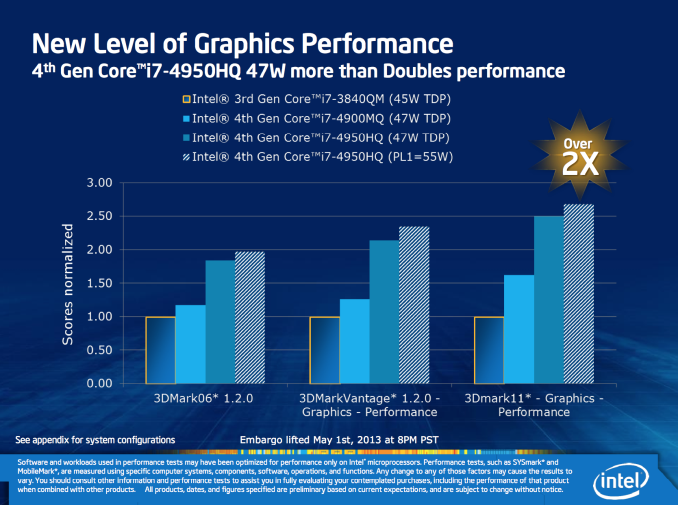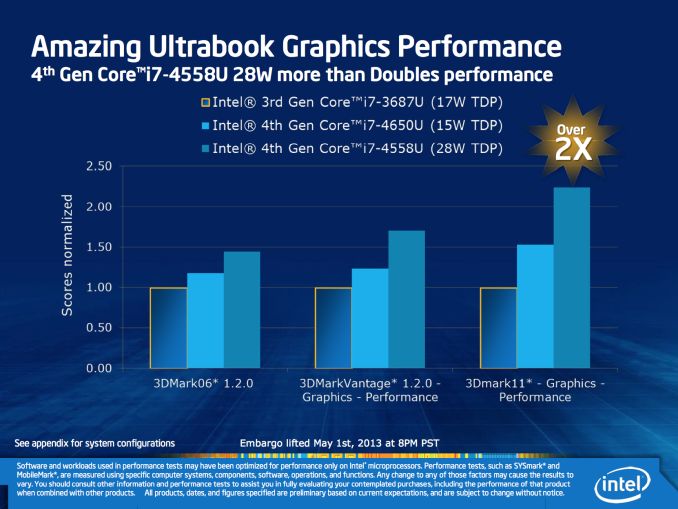Some Haswell TDPs Revealed: 15W & 28W Ultrabooks
by Anand Lal Shimpi on May 2, 2013 2:08 AM EST
Tonight Intel gave its (high-end) processor graphics a new name: Iris. Along with the new brand disclosure, Intel did let a few details slip about Haswell TDPs.
High-end desktop parts creep up to 84W (Core i7-4770K). All socketed desktop Haswell CPUs will either use Intel HD Graphics (GT1) or Intel HD Graphics 4xxxx (GT2). There's a new category of BGA-only (non-socketed) desktop CPU with an R-suffix that will ship with Intel Iris Pro graphics 5200 (GT3e). These R-series SKUs will top out at 65W, implying lower max CPU frequencies than the K-series SKUs but obviously delivering better graphics performance.
Quad-core notebook parts climb up from 45W to 47W, and these are the only parts that have the chance of getting Iris Pro graphics. Based on what we know thus far, an H-suffix seems to imply Iris Pro (Core i7-4950HQ) while an M-suffix is plain old Iris (Core i7-4900MQ). With an increase in TDP, it's entirely possible that we won't see any battery life improvement from quad-core mobile Ivy Bridge to Haswell unless you start including power savings from potentially getting rid of a discrete GPU.
Finally, the more interesting TDPs we have are down in Ultrabooks - these are parts that we've been calling Haswell ULT. Currently, Ultrabooks use 17W Ivy Bridge parts but those TDPs drop slightly with Haswell ULT down to 15W. There's no room for Iris down in the 15W range (power constraints, Intel doesn't want to regress on CPU performance), however Intel will be introducing 28W Haswell ULT parts to enable 14/15" and larger Ultrabooks with Iris graphics. The inclusion of a 28W Ultrabook part is very interesting as it clearly goes after notebooks like the ASUS UX32VD that attempted to pair a low end discrete GPU with low-power Intel silicon. Intel definitely has its eyes set on eating more of the BoM in the PC market, at the expense of the discrete GPU vendors of course. It will be very interesting to see how things play out over this next generation with low-end to mid-range discrete GPU attach rates.












30 Comments
View All Comments
GuniGuGu - Thursday, May 2, 2013 - link
How do these benchmark compare to the current GPU offerings such as the popular Nvidia 650m?GuniGuGu - Thursday, May 2, 2013 - link
To answer my own question: Nootbookcheck ran the numbers:"Intel also listed the new Core i7-4558U, which features 28W of TDP and is designed for larger 15" devices. This CPU managed performance that was 2.25 times that of the 3687U, garnering a score of around 1,350 points. Astonishingly, this is not only faster than AMD's Radeon HD 7660G, but also rivals that of the dedicated GeForce GT 640M LE"
http://www.notebookcheck.net/Intel-releases-perfor...
ShieTar - Thursday, May 2, 2013 - link
You can compare the old HD4000 vs the 650M using AnandTechs own Bench database:http://www.anandtech.com/bench/Product/601?vs=622
3dMark 11 sees the 650M as a 3x favorite, so the GT3e seems to get more or less the same score. For real games, HD4000 was trialing the nVidia card with factors between 2 and 4, so it will be interesting to see real-world benchmarks for the new parts.
Kabij2289 - Thursday, May 2, 2013 - link
I wonder how AMD's next gen APU's graphics will fare compared to Iris or Iris Pro.AMD probably prepared for Intel to step it up in GPU performance, it's just a matter of if they expected that much of a step up....
ShieTar - Thursday, May 2, 2013 - link
They absolutely did. They know that graphics performance scales very well with the number of execution units, and Intel has announced a long time ago that they would double the number of EUs. So twice the performance is exactly what everybody expected from Haswell.B3an - Thursday, May 2, 2013 - link
So if the 15W parts don't have Iris, then what do they have? HD4000 still?B3an - Thursday, May 2, 2013 - link
And will these 15W parts also be going in tablets? Because i think we was all expecting better than this from Haswell. What happened to the sub 10W parts Intel was showing off?kirilmatt - Saturday, May 4, 2013 - link
All of Intel's ULV Haswell parts are getting released later then their high-end chips. It may seem like Haswell is imminent in "ultrabooks" and tablets but this is not the caseKrysto - Tuesday, May 14, 2013 - link
It was all another lie/misleading fact from Intel, and Anand, unfortunately, kept that lie alive until very recently.Haswell is only going to achieve a 10W TDP by doing the same thing they did with that IVB with 13W TDP, where they cut the clock speed down to 800 Mhz.
So I'll tell you EXACTLY what Intel is going to do. They will release a 800 Mhz or so Haswell version for "mobile". They will start lying about its real clock speed, though, just like they are doing for Atom now, and say it's actually a 1.3 Ghz or higher chip (with Turbo-Boost, but of course they'll 'forget" to mention this in their press releases). Then they'll probably tell the second lie, that it's a "7W chip" ("whoops, did we also "forget" to mention it's SDP, not TDP?")
Re-read what I said again, remember it, then comeback in fall and tell me how wrong I was. But I'm thinking I'm not wrong at all. I've been paying VERY careful attention to Intel's press releases in the past 2 years, and they are anything if not EXTREMELY MISLEADING. And Anand is not helping by repeating their lies in his podcasts and posts.
tipoo - Thursday, May 2, 2013 - link
4600 maybe.